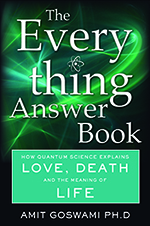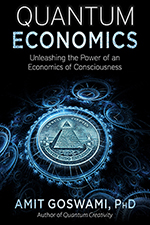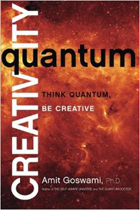This is the first in a proposed series of interviews exploring new ideas that may, perhaps, serve as salves for our troubled times.
The queries are mine, the responses Amit’s.
Rajani
Professor Rajani Kanth is an economist, philosopher, and social thinker
He has served as an Advisor to the United Nations, in New York.
He has taught in the areas of anthropology, sociology, political science, history, economics, and philosophy.
His research interests lie in political economy, peace studies, gender studies, cosmology and the environment.
An Affiliate at Harvard University (2007-2017), he is Trustee of the World Peace Congress.
He is the author/editor of several academic works in political economy and culture-critique. He is a novelist and poet and has also scribed several screenplays.
His most recent books are: Farewell to Modernism, Peter Lang, NY, 2017; and The Post‐Human Society, De Gruyter, Warsaw, 2015.
IDEAS FOR OUR TIMES
An Interview with Amit Goswami, PhD
Pertaining to Quantum Physics, Consciousness, and the Human Condition
Interview by Professor Rajani Kanth
1. Explain what you mean by your key phrase: “Consciousness is the Ground of Being”.
Quantum physics indicates that material being arises from possibilities, possibilities of consciousness.
“Consciousness is the ground of all being” is a generalization. All manifest being—sensing, thinking, feeling, intuition—arises from consciousness.
2. How does that differ from any other extant view of consciousness or being?
The idea of a “ground” different from space and time is experimentally verified in quantum physics defined by instantaneous signal-less communication or nonlocality (space and time is local; communication requires signals taking time).
Nonlocality translates as unity—oneness of everything for this domain of potentiality or consciousness.
Except for the wisdom traditions, nobody talks about consciousness this way.
3. How did you chance upon that novel idea?
While I was having a heated argument with a mystic friend.
In retrospect, the idea was the culmination of a creative process that extended over about ten years.
4. You reject scientific materialism: Why?
Nonlocality, an experimental fact, simply rules it out.
We have transferred potential experiments (replicated in many laboratories all over the world) which show that electrical potential can be transferred from one brain to another provided the two subjects are able to hold the meditative intention that they will have direct communication.
Even neuroscience experiments are now supporting the new view of consciousness and how it manifests in the brain as a self.
Besides, there are so many experiential reasons.
5. Does quantum physics really displace classical (Newtonian) physics? Where, and why?
Yes, quantum physics really does replace Newtonian physics for all matter, micro and macro.
However, for the macro-world, Newtonian predictions approximately hold; in this way, materialists can argue if quantum physics has enough effect on a macro-object, like a brain, for consciousness to be relevant.
I have shown that living matter is quantum because it is non-locally correlated with what [are] called subtle bodies—potentialities that give rise to our subtle experiences of feeling and thinking.
6. Is it true the old physics was deterministic whereas the new physics is probabilistic? Does that matter? Why?
Yes, it is true. Quantum objects are waves of possibility.
It matters when we realize that these waves reside not in space and time, defined by locality, but in another domain outside space and time, defined by nonlocality and oneness.
This oneness is consciousness.
7.The social sciences have always suffered from “physics envy”: Are they justified?
I don’t know!
I guess the physics envy comes from the fact that physics is mathematical; but in all their efforts nobody has been successful in developing a mathematic macroeconomics that work.
In the new paradigm, social science no longer is constrained to be deterministic. Freedom is back!
They can relax.
Mathematics does not apply to social sciences.
8. There is a lot of “quirkiness” to quantum physics in the popular mind. Please explain.
There is no quirkiness to quantum physics. All the quirkiness is in the mind of scientific materialists. If you have the wrong lens, reality looks muddled up, paradoxical.
9. You have produced works that extend the quantum notion to economics, biology, et. al. Is that valid?
Those are natural extensions to make these sciences apply to conscious beings like humans who have freedom, who have nonmaterial experiences, even experiences of a self separate from the world.
Right now, what we call biology or economics only apply to machines.
We live in a topsy-turvy world in which biologists fight phantom creationists rather than recognize that Neo-Darwinism does not explain fossil gaps or the purposiveness of evolution revealed in fossils data evolving from simple to complex.
I wrote a book, Creative Evolution, which explains all the data on evolution.
Materialists hold on to the notion that quantum physics is for the micro-reality; it does not apply to the macro. But life, a biological organ, is coupled to “subtle bodies” — subtle movements — that we feel or think.
It is these subtle movements that are quantum; the physical organ becomes quantum by virtue of nonlocal correlation with the subtle.
It is all explained in the book quoted above.
10. You were featured in a film called “What the Bleep Do We Know?” Your critics felt that you turned science into vulgar populism (activism) thereafter? How do you react?
Amusement, as I look at Trump today.
Scientific materialists created the idea of “fake news.”
Just as we have to turn back Trumpism with political activism, so also with quantum activism we turn back scientific materialism.
It is slow, but we are gaining traction.
11. You argue that so-called “nonlocality” proves the existence of another domain beyond space-time? Please explain.
I already explained it above. See my answer to Question Two.
Nonlocality—signal-less communication—confirms that quantum potentiality resides in a definably different domain of reality; different from space and time where locality reigns.
12. But there is no meaningful communication at all in the “nonlocality” experiments that you cite. So why is it important?
This is pure misunderstanding.
Somebody proved a theorem that information cannot be transferred via nonlocality; but the theorem is valid if interactions are all material.
When consciousness and conscious choice enters the picture, the theorem is no longer valid.
13. Does that also imply that telepathy, ESP, etc., are all valid?
It sure does, as I have argued in my book God is not Dead.
These ideas are experientially verified by millions of people every day; even many scientists tacitly accept their existence.
But the official position of American physical society does not change. How dogmatic is that?
14. You suggest Jesus, Buddha, et. al, were all on the right track: What do you mean? Does God exist?
Careful about that word God!
For most Christians, God is a super-duper human being sitting on a throne in heaven doling out rewards and punishments. Don’t forget; this is not a scientific picture, and materialists are justified [in] fighting it.
The God of quantum science, if you insist on using the word, and as I have used that word in my book quoted above, is unity consciousness.
15. But are science and religion compatible, in your quantum frame?
Quantum science is compatible with religion in its esoteric core (where unity consciousness is recognized as the ground of being) but not with exoteric religions of popular understanding, where unity consciousness is caricatured by so-called monotheistic concepts of God, etc.
This is a huge problem.
Do we throw the baby out because of the dirty bathwater?
16. Please explain the particle/wave distinction: Why do you think that matter exists in a domain of possibilities prior to the “wave-function collapsing,” via sentient observation?
Particles can exist only at one place at a time; waves can be in many different places at the same time. Obviously, they cannot co-exist in the same domain of reality.
There is no wave-particle duality in quantum physics except in the materialist’s mind. Quantum math clearly says quantum objects are waves.
To connect quantum math with [an] experiment, we have to invoke measurement which converts waves into particle. And measurement cannot be defined without [a] sentient observer.
Scientific materialists refuse to understand what John von Neumann, and later I, clarified long ago. Quantum measurement is about how the unity (consciousness) splits into two: subject (observer) and object.
To understand quantum physics, you have to understand and include the subject in your philosophy.
Materialists can’t. They are stuck with only objects. When you have only a hammer in your hand, you go on insisting that the world is nails.
17. If the observer is so important, then is it an anthropic universe? What about the distinction between observer/observed is so important to scientific realism?
It is an anthropic universe, and why do people prefer a machine universe?
There is also that well-argued anthropic principle.
Scientific realism cannot stand the idea of [an] observer.
18. What do you mean by a “Self-Aware Universe,” the title of your major work?
That the universe is self-aware through us, manifest through us; only we living beings experience the universe which exists only in our ongoing experiences.
We are here because of the universe, no doubt; but the universe is here because of us.
19. Who agrees with you in the scientific community?
Among big name physicists, there are only a few such as Henry Stapp and Casey Blood, maybe Fred Alan Wolf, too.
But I have a huge following in the healing community, both physical healers including mainstream doctors, and psychologists.
I was deeply touched when the famous psychiatrist and consciousness researcher Stan Grof, at a conference in Prague, openly acknowledged my work and quantum science having given the scientific basis for transpersonal psychology, a brain child of his and others.
I think only the descendants of what you call Euro-modernism are the major hold-outs.
20. How does traditional Darwinian evolution fit in with your quantum views?
Like a sore thumb.
I have already referred to my book called Creative Evolution above, correcting the shortcomings of Darwinism with a consciousness view of evolution.
Darwinism is like Newtonian physics in the new biology; it holds for evolution within a species or small changes of microevolution.
To understand macroevolution, you got to bring in quantum leaps.
21. Is there a crisis in physics with Newtonians, Einsteinians, and quantum physicists, all disagreeing about fundamentals?
Yeah, the antagonists all disagree that subjects exist, that living beings exist, beyond what their little lens allows them to see.
Oh, where is Paul Dirac now who said, “In order to see a great new truth, you have to give up a great old prejudice.”
Scientific materialists have to give up materialism; it is not compatible with experiments. There is a domain of nonlocality; there also is nonmaterial “stuff,” both ideas verified by experimental data.
Let us be scientific, folks.
22. You have also stepped — trespassed? — into the domain of healing. What is quantum healing?
Quantum healing consists of quantum leaps of healing, producing a discontinuous leap from disease to wellness.
I have shown that the creative process can lead to quantum healing, and that idea, too, is being verified as large numbers of people are using it to get healed.
23. You suggest that ancient Indian and Chinese philosophy (yoga, chi, chakras, Ayurveda , etc. ) have useful insights to offer us: What do you mean?
They do, but you have to accept the idea of nonphysical subtle objects to see the cogency of these philosophies and practices.
Yoga, Ayurveda, TCM, are all about movements of vital energy, a nonphysical energy connected with purposive functions of life.
It is possible to measure these energies now; that should end the debate.
24. Do you still see yourself as a normal scientist, carrying on scientific research?
Yes, of course.
I am a normal scientist without abnormal lenses on the eyes.
25. Is there any scientific caution you adopt toward your own notion of “consciousness is the ground of being”: Is it, e.g., disprovable? How?
Of course.
Recent neuroscience studies of people who delve into loving kindness, creative, and meditative practices for a long time are showing nonlocality in the brain that signifies that these people “live” in nonlocal consciousness.
All materialists need to do is to find [an] explanation of these data without resorting to nonlocality to “disprove” the idea of nonlocal consciousness.
26. What do you think of transhumanism? Does it use any quantum insights?
It would be better for it if it did.
27. Is there a website you can direct the curious to?
Yes, thanks: www.amitgoswami.org.
28. Name your most important works.
The Self-Aware Universe; Physics of the Soul; The Quantum Doctor; Creative Evolution; How Quantum Activism Can Save Civilization; Quantum Creativity; Quantum Economics; and the upcoming The Quantum Science of Happiness.
29. What is the biggest danger facing humankind today in your opinion?
I am not oblivious of the perils of global climate change, terrorism, Trumpism, failed economics, and all that.
It may sound far-fetched, but please note that scientific materialism contributed to all of these potential disasters.
Also, please note that adapting a quantum worldview in our society will go a long way toward correcting the trend.
My book How Quantum Activism Can Save Civilization gives all the details.
30. What is the future of your own interpretation of quantum physics?
It is experimentally verified. Transferred potential from brain to brain, nonlocal self-modality in the brain; those are replicated data.
Experimentally verified scientific ideas are forever.
[©R.Kanth, 2018]



